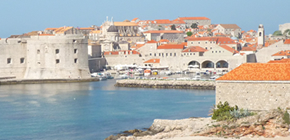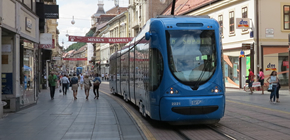 Loading... Please wait...
Loading... Please wait...Travel Info
Our Newsletter
- Home
- Travel Info
Travel Info
|
|
What do an adorable Dalmatian (dog) and a tie have in common?
The answer is that they both originated in Croatia.
|
The Republic of Croatia is located on the eastern side of the Adriatic Sea in southern Europe. Across the Adriatic Sea lies Italy. The shape of Croatia’s territory looks like a soaring bird. Having more than one thousand islands along the Adriatic coast, Croatia is known as “the country of thousand islands”. Croatia is often considered as a “Balkan Country” probably due to historical reasons. "Balkan" is a Turkish word which means “wooded mountain range”. But the word "Balkan" fails to describe Croatia. The country is blessed with diversities: sunny beaches with crystal clear waters, national parks with different geological features, historical heritages of distinct cultural origins, traditional vineyards and countryside with their own customs. The Mediterranean style mingles with the Continental flavour in Croatia. When the country was under the rule of the Roman or the Austrian-Hungarian Empire, Croatia offered aristocracy the best summer retreats. When the country has regained independence in the modern era, Croatia lets guests from all over the world escape from the hustle and bustle of everyday life. In this rare paradise on earth, lakes, rivers, waterfalls, mountains and verdure form picturesque sceneries and poetic beauties. On this pristine land of culture and traditions, the historical heritages from different empires and cultures survived thousands years of turmoil. HistorySigns of human habitation have been found in the present day territory of Croatia since prehistoric times. The Illyrians, the Greeks and the Celts successively entered and settled in the area. The Roman Empire conquered the Illyrians at different times since the 2nd century BC. By 12 AD the Romans ruled the whole area. Different tribes invaded the Balkans since the fall of the Roman Empire. The Huns, the Ostrogoths, the Slavs and the Avars successively conquered different towns and areas in Croatia. In the early 7th century a Slavic branch (likely the earliest Croats) migrated to the area. In the beginning, they settled in the coastal area of Dalmatia, which was then ruled by the Byzantine Empire. In the 8th century they expanded northwards and inland. Two separate Croatian states emerged then. Charlemagne led the Franks to take over Pannonia (approximately the territory of the present-day eastern Austria, northern and eastern Croatia and western Hungary) between the late 8th century and the early 9th century. Meanwhile, Croats started the conversion to Christianity. The area has eventually become part of the Roman Catholic Church. Tomislav was enthroned in the year 925. He was the first king of the united Kingdom of Croatia. In the 11th century, the Kingdom of Croatia reached territorial peak under King Petar Kresimir IV. In 1102, the Hungarian king Koloman conquered Croatia. The two countries agreed to let the Hungarian king be the monarch of Croatia. Despite keeping her autonomy and noble privileges, Croatia became a vassal state of the Hungarian Empire and, later, the Austrian-Hungarian Empire for the following 800 years. The obligations of a vassal often required Croatia to stay in the frontline against foreign invasion (against the Ottoman Empire for one). Following the collapse of the Hungarian Empire in the late 16th century, most areas in Croatia were under the control of the Ottoman Empire (Dubrovnik remained an independent kingdom between the years 1382 and 1808. The Venetian Empire bought the remaining area of Dalmatia in 1409 and ruled the region until 1797). By the 19th century, the present territory of Croatia, including Dalmatia, became part of the Austrian-Hungarian Empire. Therefore, different parts of Croatia were influenced at different periods of times to varying degrees by Hungary, Venice, the Ottoman Empire and Austria. Croatia, Serbia and Slovenia once formed a unified kingdom after World War I. In 1945, six states, including Croatia, constituted the federal republic of Yugoslavia. On May 19, 1991, Croatia held a referendum. With the support of 94% of the voters, Croatia officially broke away from the federation and declared independence on June 25 the same year. IntroductionThe Republic of Croatia was founded in 1991. The Statehood Day is May 30. Croatia is a member country of the United Nations (UN), the World Trade Organization (WTO), the Central European Free Trade Agreement (CEFTA), the Union for the Mediterranean and the North Atlantic Treaty Organization (NATO). On 1st July 2013 Croatia became the 28th member country of the European Union (EU). AreaCroatia covers a total surface area of 87,667 sq. km of which the mainland occupies an area of 56,594 sq. km. The total coastline, including both the mainland and islands, is approximately 6,000 km of which 1,778 km belongs to the mainland. Administrative DivisionsThe whole country comprises 20 counties and the capital city of Zagreb (having the authority and legal status of a county and a city at the same time). The main cities include Split, Rijeka, Dubrovnik, Osijek, Zadar, Šibenik, Pula and Varaždin. PopulationCroatia has a total population of about 3.9 million people (as of 2021 data) , nearly 90% of whom are Croats. The population density is approximately 76 persons/sq. km. LanguageCroatian is the official language. Most official government documents and information release aimed for an international readership are also available in English. Younger generations often speak pretty good English, whereas the elderly people living in the coastal towns may speak some German or Italian. Over 98% of the population are literate.
|
|



